Violet Backed Starling: Field Guide, Pictures, Habitat & Info
Last Updated on
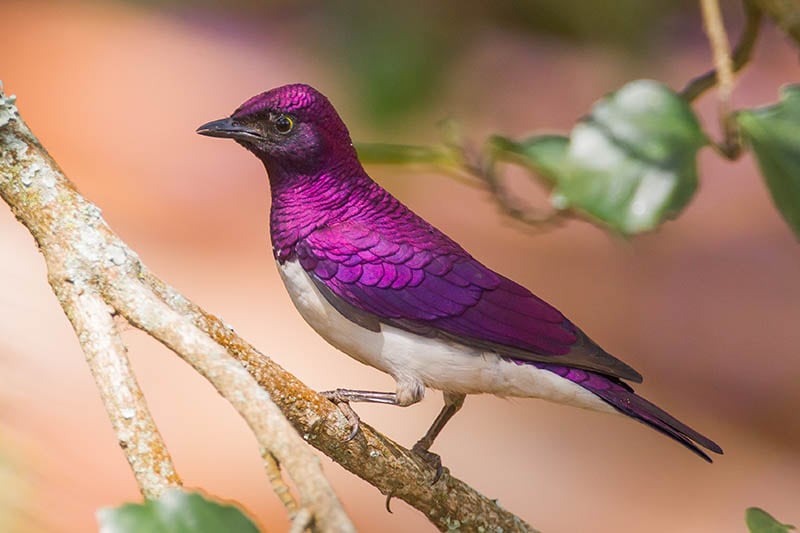
You are not likely to see a Violet-Backed Starling at a bird feeder in your backyard—unless you live in sub-Saharan Africa. It is pretty common in several countries. It is an adaptable bird, not unlike its Northern Hemisphere counterpart, the European Starling. It lives in a broad spectrum of habitats with an equally large diet consisting primarily of fruits and seeds.
There are three subspecies, each with distinct ranges that affect their behavior and respective breeding seasons. Some are year-round residents, while others are migratory.

Quick Facts about Violet Backed Starling
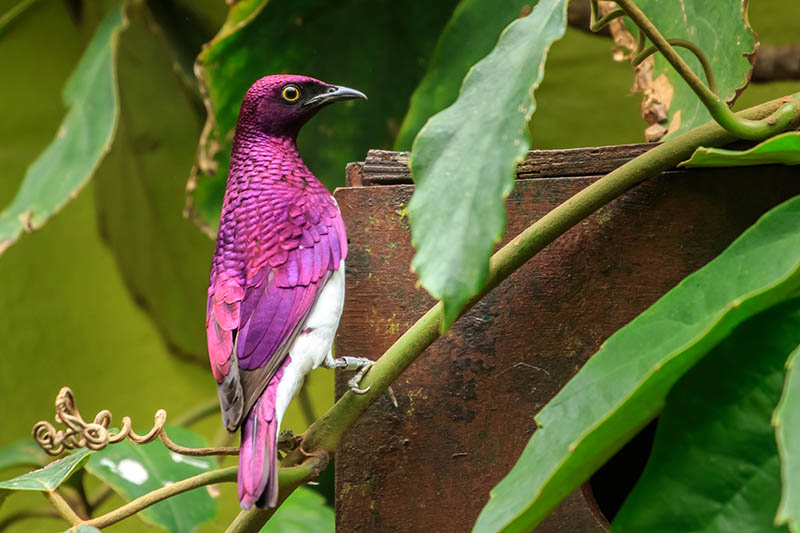
| Habitat: | Agricultural fields, savannas, wetlands |
| Diet: | Fruits and occasionally insects |
| Behavior: | Diurnal; typically seen in the canopy |
| Nesting: | Seasonally, with the timing depending on the location |
| Conservation: | Species of Least Concern |
| Scientific name: | Cinnyricinclus leucogaster |
| Lifespan: | 4 years |
Violet Backed Starling General Description
The Violet-Backed Starling is a striking bird, as its name implies. It is a member of the Sturnidae or starling family and the only one of its genus. The species is sexually dimorphic in the most classic example of the term. The male has iridescent purple on his entire head, neck, and back. Its underside is white and provides an attractive contrast to its darker-colored plumage.
The bird also has a black streak going from its gray bill to its dark-colored eyes. The female couldn’t be more different. Her plumage is tan extending from her head to her back with brown streaks. Her white chest has a similar striped pattern. Her bill and legs are gray. This muted coloration provides excellent camouflage.
Violet Backed Starling Range, Habitat, Behavior, Diet & Nesting
The Violet-Backed Starling is also known as the Amethyst Starling, a fitting moniker for this colorful bird. Its habitat, diet, and nesting behavior are similar to other species in this family. This group is native to several continents, including Australia, Asia, and Europe. The iridescent sheen of its plumage is a common trait among the various species.
Range
The Violet-Backed Starling lives just about any place in sub-Saharan Africa, barring the environmental extremes of the desert and rainforest climates. The Cinnyricinclus leucogaster arabicus subspecies lives in the Middle East and countries in eastern Africa, including Somalia and Ethiopia.
The Cinnyricinclus leucogaster leucogaster lives north of the Equator in Uganda and Sudan, with non-breeding populations along the coast. The range for the third subspecies, Cinnyricinclus leucogaster verreauxi, includes Angola, Kenya, and Namibia.
Habitat
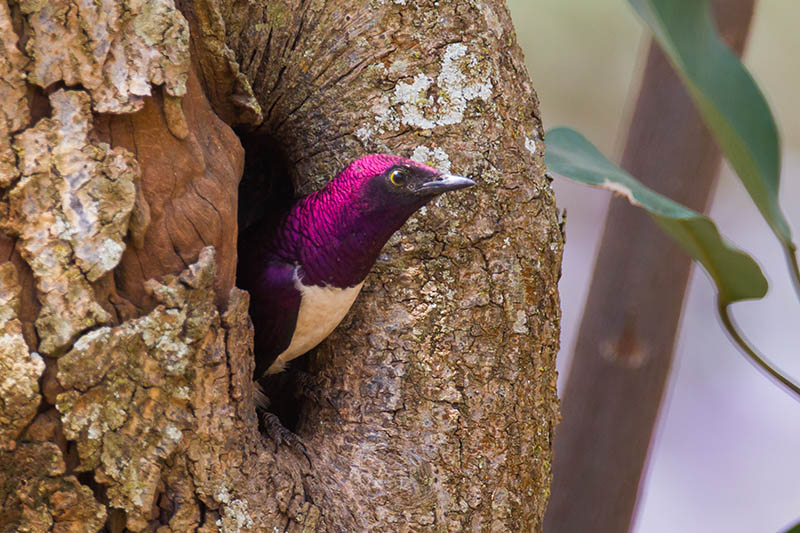
One of the reasons for the Violet-Backed Starling’s ecological success is its adaptability. That comes into play with its varied habitats. You’ll find it in open forests, along waterways, and in parks. It particularly likes habitat edges to take advantage of the resources both offer. Being used to the presence of humans is a point in its favor, too.
Behavior
The Violet-Backed Starling behaves like others of its ilk. It is noisy and active, with a repertoire of up to 15 vocalizations. It is worth noting that other species in its family include mynahs, well-known for their talking ability. This bird can even learn to imitate humans. It is a diurnal species and usually stays in small groups outside of the breeding season.
Some starlings are migratory and will travel north to their wintering grounds in Africa. However, other birds are permanent residents, with movement typically a function of their location. Unlike North American species, rainfall is the driving factor.
Diet
The Violet-Backed Starling prefers fruits and seeds as its primary diet. This bird prefers to stay above ground in the trees and canopy. It’s a rare thing to see one foraging on the ground. It will also take insects on the wing, a feeding strategy that scientists call hawking. It’ll grab them in their bills instead of the talons that a raptor would use.
Nesting
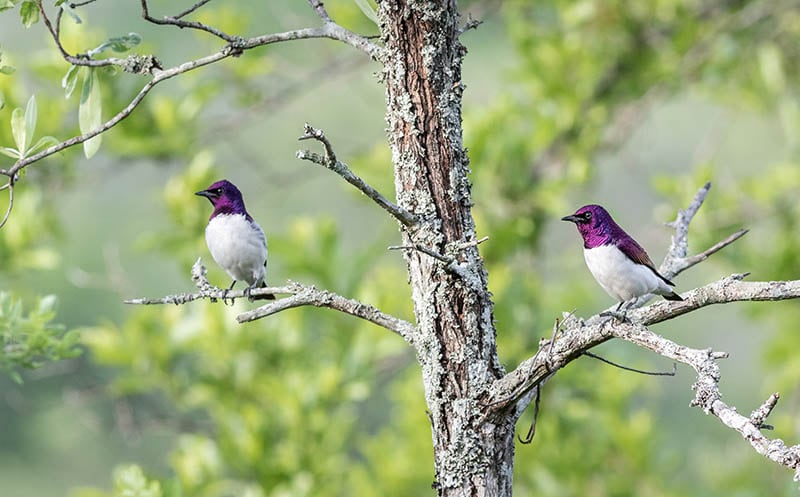
The species is monogamous. While it will stay in small flocks, pairs split off from the constellations of starlings to mate. The pair makes its nest in a cavity or other opening or crevice. The female will lay three to five eggs, which only she will incubate. The male will feed her and sing to defend his territory. The nestlings will hatch in about 12–14 days. Both parents will take care of the young.
How to Find Violet-Backed Starling: Birdwatching Tips
Violet-backed starlings are gregarious and used to the presence of humans. You probably won’t have any problems spotting them. Of course, the vibrant coloration of the male’s plumage makes it easy to find them.
What to Listen For
The Violet-Backed Starling isn’t as boisterous as its European counterpart. It makes a variety of sounds and calls, from shirl whistles to chirps instead of a distinct song. Remember that it can imitate people, so its vocalizations will likely include some unusual sounds.
What to Look For
If you’re looking for the Violet-Backed Starling, you have to look up into the trees. The male’s purple coloration will provide a stark contrast to the green vegetation, allowing the bird to stand out easily. It’s also helpful that this species isn’t flighty or shy. It’s most often seen in open areas, making foliage less of an issue. You can also spot them when termites are abundant.
When to Look
The Violet-Backed Starling is most active during the day, with a midday rest during the hottest time. If the insects are flying, you can expect to see the birds hawking for food.
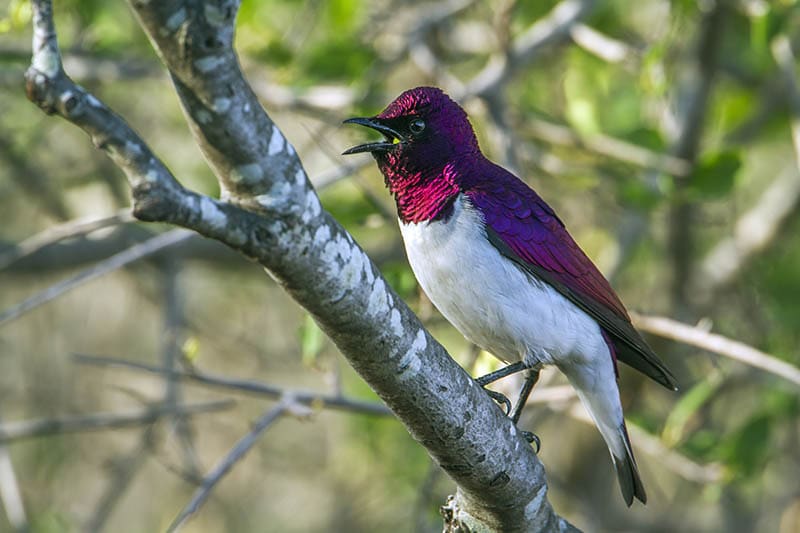
Violet-Backed Starling Conservation: Is This Bird Threatened?
The International Union for Conservation of Nature and Natural Resources (IUCN) lists the Violet-Backed Starling as a species of least concern. Although its numbers have declined in recent years, it has an extensive range on the African continent. It’s also occasionally seen in the United Arab Emirates, Mauritania, and Israel. An estimated 32,000 birds live in Kruger National Park in South Africa alone.

Final Thoughts
The Violet-Backed Starling is a gorgeous bird that anyone would love to add to their life list. Its beautiful plumage is undoubtedly picture-worthy. Fortunately, this species makes it easy to spot. It’s safe to say that these birds are a welcome sight wherever you’re lucky enough to see one. Keep your eyes to the sky to see on the wing.
Featured Image Credit: Jukka Jantunen, Shutterstock
About the Author Chris Dinesen Rogers
Chris has been writing since 2009 on a variety of topics. Her motto with all of her writing is “science-based writing nurtured by education and critical thinking.” Chris specializes in science topics and has a special love for health and environmental topics, and animals of all shapes and sizes.
Related Articles:
10 Types of Hummingbirds in Arkansas (With Pictures)
8 Types of Hummingbirds in Nebraska (With Pictures)
5 Types of Hummingbirds in Idaho (With Pictures)
3 Types of Hummingbirds in Mississippi (With Pictures)
8 Types of Hummingbirds in Kansas (With Pictures)
5 Types of Hummingbirds in West Virginia (With Pictures)
5 Types of Hummingbirds in Ohio (With Pictures)
Where Do Nuthatches Nest? Nuthatch Nesting Habits Explained
